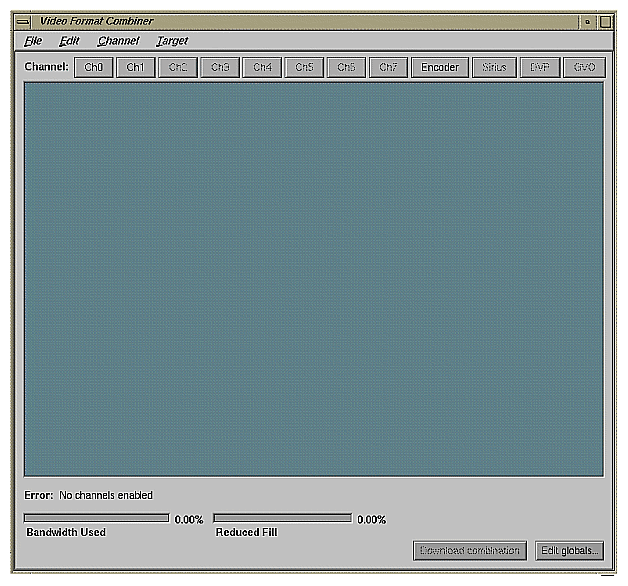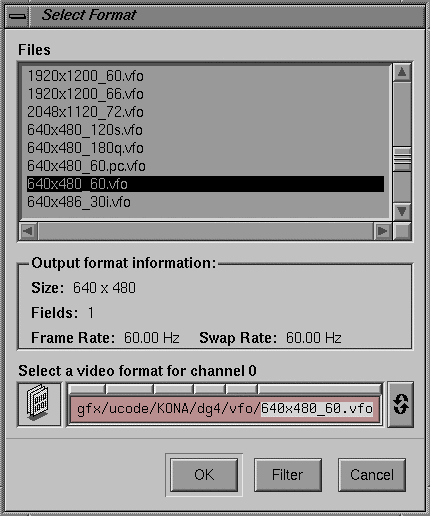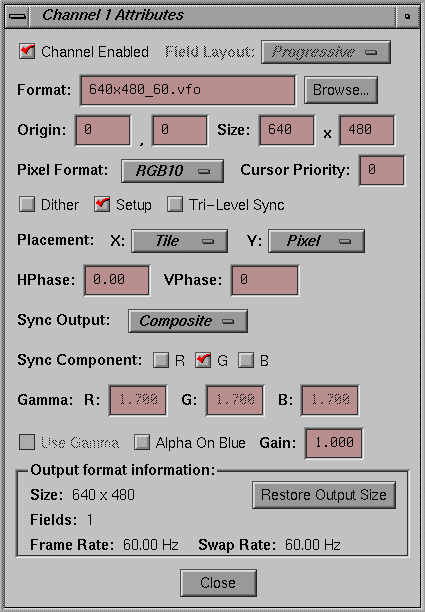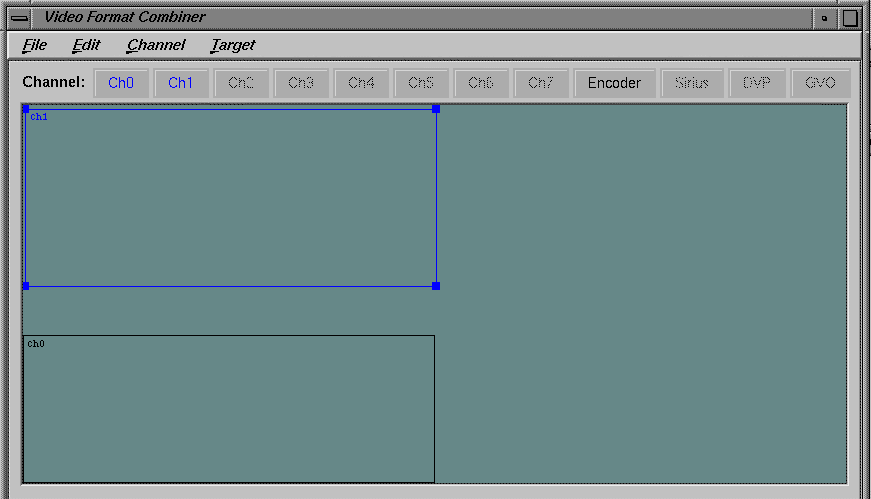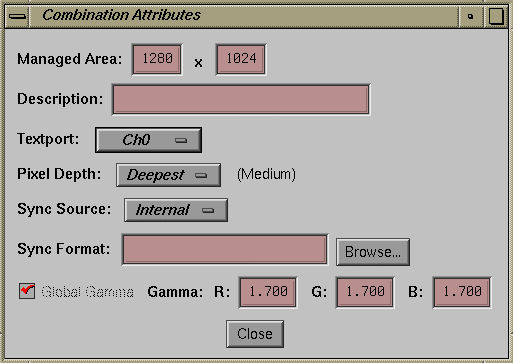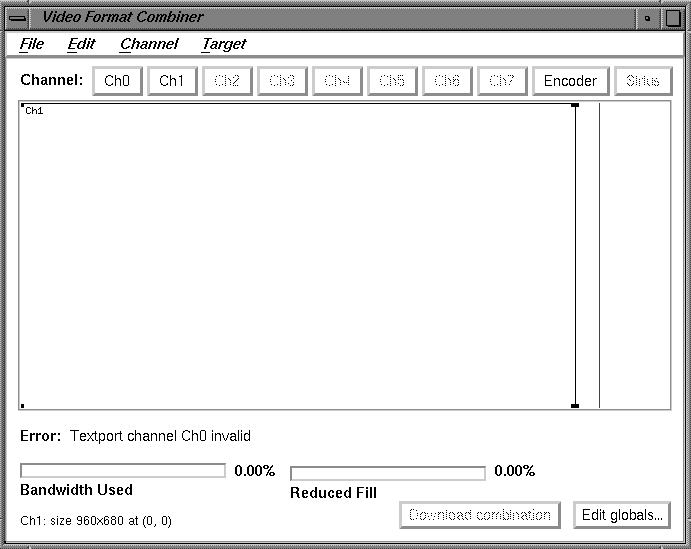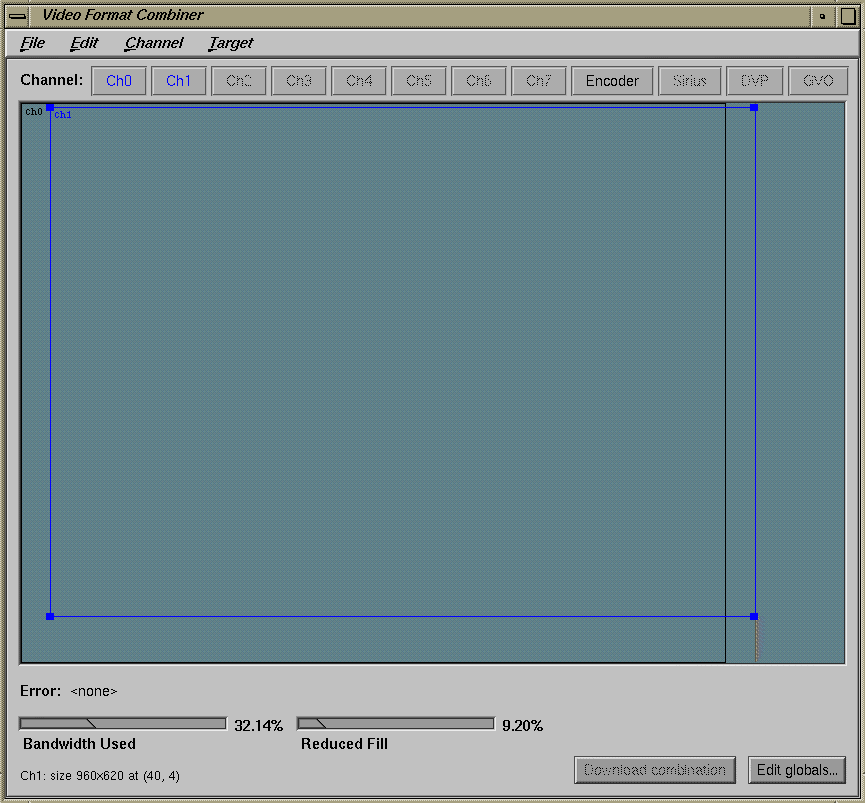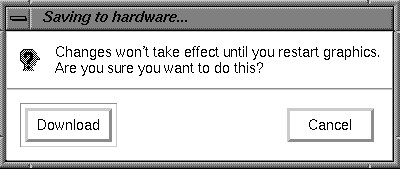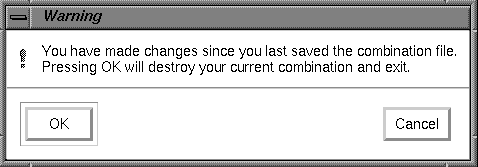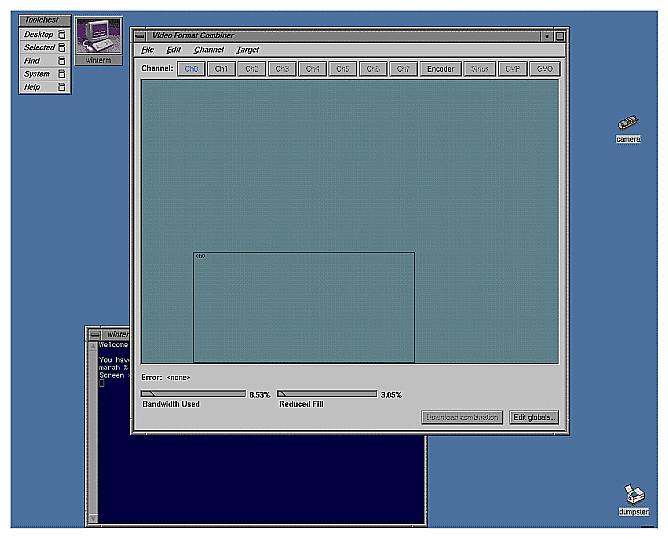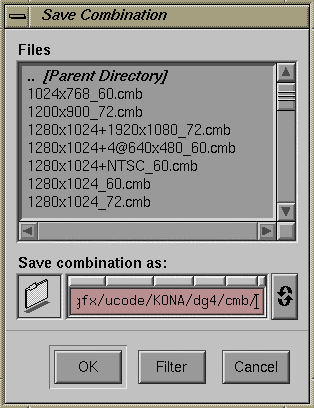This appendix consists of example exercises designed to demonstrate tasks you can perform using the Combiner. It consists of these sections:
The instructions for redisplaying graphics are included in case the monitor stops displaying video during one of the examples (or at any other time).
The example exercises in this appendix are based on the assumption that a Silicon Graphics multisync 21-inch monitor is connected to Channel 0. If the monitor attached to Channel 0 is unable to sync to any of the formats used in the example, it ceases displaying video.
The first time InfiniteReality graphics was initialized, or during the first power-on of the system with InfiniteReality graphics installed, the video output was defined for the channels available on the workstation. To reinitialize graphics, enter
(/usr/gfx/stopgfx ; /usr/gfx/startgfx) & |
at the IRIX prompt. Note that the parentheses are necessary.
Figure A-1 shows an example of the main window interface.
Each example starts from the Combiner's main window.
This exercise consists of
Each procedure is explained in a separate section.
Before modifying and downloading new video format combinations, you can avoid having to reboot the graphics system if you select a combination of window sizes that do not encompass the Combiner main window controls or an IRIX shell window. Follow these steps:
Bring up an IRIX shell window and reduce it to 80 x 24 using the size option on the pulldown menu from the right mouse button.
Drag the IRIX shell to the lower left corner of the screen.
Launch the Combiner main window.
Position the Combiner's main window in the upper left corner of the screen.
Resize the Combiner's main window so that none of the IRIX shell window is covered: click the lower right corner of the Combiner main window and move it upward.
To select the first channel to modify (Channel 0), follow these steps:
Click Ch0 in the Combiner main window. This selection corresponds to the Chan0 connection on the InfiniteReality system's I/O panel.
In the Select Format window that appears, select the 640x480_60.vfo file as the video format for that channel; see Figure A-2.
Click OK. The Ch0 rectangle appears in the Combiner's main window.
Associate Channel 0 with the IRIX shell window at the lower left:
Select “Grab window...” in the Channel menu. A crosshatch cursor appears.
Move the crosshatch cursor to the IRIX shell at the lower left of the screen and click the left or right mouse button.
The Combiner uses the position and size of the IRIX shell for Channel 0.
Select and modify Channel 1 using the following steps:
Click Ch1 on the main window.
In the Select Format window that appears, select the 640x480_60.vfo file.
Click OK. A Channel 1 (Ch1) rectangle appears in the upper left portion of the Combiner main window.

Note: In this example, you set the origin of Channel 1 precisely to (4,10). You could do this by clicking on the line of the rectangle and dragging it, as you did for Channel 0. However, in this exercise you specify the Ch1 origin numerically by editing the Ch1 attributes in the following steps. Bring up the Attributes window by double-clicking the Ch1 button in the Combiner main window. The Channel 1 Attributes window appears, as shown in Figure A-3.
Replace the value in the left Origin box (the x-origin box) with 4 and press Enter. Move to the right Origin box (the y-origin box) and replace the value with 10 and press Enter. Click Close to close the Channel 1 Attributes window.
Figure A-4 shows Channels 0 and 1 in the Combiner main window.
In the Combiner main window, click Download combination.
At this point, the video system is displaying the configuration specified in the exercise just completed:
Channel 0 is displaying the lower left portion of the framebuffer where you originally placed the IRIX shell window.
Channel 1 is positioned according to your entries in the Channel 1 Attributes window.
To return to the 1280 x 1024 video output, enter /usr/gfx/setmon -n 1280x1024_72 in the IRIX shell window.
Go on to the next example or close the Combiner's main window.
Before starting this exercise, be sure to read the information in “Reinitializing Graphics”. “Reinitializing Graphics and Starting Combiner”
This example assumes that the Combiner main window is open. If it is not, follow the instructions at the beginning of this appendix.
In the Combiner main window, select “New” from the File pulldown menu. Then click OK in the warning box. You are now ready to create and save a new video format combination to the EEPROM. The video format consists of two channels; each one is a 960x680_60.vfo format. Use the following steps to make and save all the changes:
Click Edit globals in the main window's bottom right corner. The Combination Attributes window appears, as shown in Figure A-5.
Change the Managed Area fields at the top of the Combination Attributes window to read 1000 in the left-hand box and 680 in the right-hand box. These actions redefine the allocated part of the managed area so that it is smaller than the managed area.
The Combiner always shows the allocated area to make it clear that memory is being made inaccessible if the managed area size differs from that of the allocated area. The red line that appears indicates the boundary of the allocated area.
The area to the right of the red line represents unallocated memory; this part of the managed area is inaccessible, and the Combiner does not permit you to position channels in that area (until you redefine the managed area in the Combination Attributes window).
Click the Combination Attributes window's Close button.
Click Ch1 in the Combiner's main window. The Select Format box appears.
Find and double-click the 960x680_60.vfo file format. An error message appears at the lower left corner of the Combiner's main window, as shown in Figure A-6: “Textport channel Ch0 invalid.”
When this or any other error message appears in the main window, you cannot use the Download combination or Save to EEPROM functions. In this example, the error condition goes away after you define Ch0.
Click and drag the Channel 1 box on the main window to the right until it is blocked by the red vertical line.
Click Ch0 in the Combiner main window.
In the Select Formats box that appears, find and double-click the 960x680_60.vfo file format.
At this point, you have specified a video format combination with two video formats that are both equal to 960x680_60. The two channels are slightly offset but mostly overlapping, as shown in Figure A-7.
In the File pulldown menu in the Combiner's main window, select “Save to EEPROM.”
In the Saving to hardware dialog box that appears, click Download (see Figure A-8).
The format combination is now loaded in the EEPROM, but it does not take effect until the graphics subsystem is restarted.
In the File pulldown menu in the main window, select “Exit.”
Click OK when the Warning dialog box appears (see Figure A-9).
Enter the following in the IRIX shell window to restart system graphics:
(/usr/gfx/stopgfx ; /usr/gfx/startgfx) &.
When the Login window appears, log in as root (superuser). The video system is now outputting a 960x680_60 format on Channels 0 and 1.
The video system retains this configuration even after rebooting because the 960x680_60 Video Format Combination is saved in the EEPROM.
To reset the EEPROM to the standard 1280 x 1024 format combination, enter /usr/gfx/setmon -n 1280x1024_72 at the IRIX prompt. Then restart the graphics system (as in step 13) to activate the format combination reset. When the Login window appears, log in as root.
Before starting this exercise, be sure to read the information in “Reinitializing Graphics”. “Reinitializing Graphics and Starting Combiner”
In this final example, you create a single-channel combination that is “static resized” and is saved to and loaded from a combination file. Follow these steps:
Open an IRIX shell window, click the right mouse button and use the Size pulldown menu to change the shell to 80 x 24.
Place the 80 x 24 shell window behind the Video Format Combiner main window, but make sure the command-line prompt is visible.
Click Ch0 on the Combiner's main window. The Select Format window appears.
Find and double-click the 1280x1024_72.vfo file. The Channel 0 (Ch0) rectangle fills the entire 1280 x 1024 managed area in the main window.
In the Channel pulldown menu, select “Grab Window.” The cursor turns into a cross.
Move the cross (cursor) into the IRIX shell window and click the mouse button. The rectangle in the Combiner's main window representing Ch0 now represents the area of the framebuffer covered by the 80 x 24 IRIX shell that you clicked in. See Figure A-10 for a screen example.

Note: This area becomes resized to fit the entire Channel 0 output when the combination is loaded. You can resize a channel's input area by clicking and dragging any of the four corners of its main window rectangle. That resizing method is not covered in this exercise. 
Caution: Do not move the IRIX shell window until you complete this exercise.
From the File pulldown menu in the Combiner main window, select “Save As.” The Save Combination window appears (see Figure A-11).
In the “Save combination as” field, type test.cmb at the end of the path and click OK.
Select “Exit” from the File pulldown menu in the Combiner's main window.
In the shell window you clicked in step 6, enter
/usr/gfx/setmon -n test
The screen blanks momentarily and then displays the IRIX shell window resized to 1280 x 1024 (the entire screen display).

Note: If no usable window appears, you can recover the default video display combination following the instructions in “Redisplaying Graphics”“Redisplaying Graphics”. Revert to the previous display configuration by entering /usr/gfx/setmon -n 1280x1024_72. The entire screen should reappear in the standard 1280 x 1024 format.
Select “Exit” from the File pulldown menu on the Combiner's main window to conclude the exercise.
If the monitor should stop displaying video during one of the examples or during any other type of Combiner use, the following steps should provide a solution:
Connect a monitor to Channel 0 that can display the required format(s). If video is still not visible, go on to step 2.
Log in to the system remotely or connect an ASCII terminal to serial port tty_1, if possible. Become superuser (root) and enter the command
/usr/gfx/setmon -n 72
If this does not work, enter
/usr/gfx/setmon -x 72
Restart the graphics by entering
(/usr/gfx/stopgfx ; /usr/gfx/startgfx) &.
Reboot the system using the System Controller if the first two steps do not work. If, after rebooting, the video still does not display, wait for several minutes and go to the next step for an additional process.
Enter 1; attempt to reboot the system to single user by entering /usr/gfx/setmon -x 72 (even though you are unable to see any screen display of your inputs). When you believe you have succeeded, reboot again.
Call your Onyx service provider for additional information and assistance if these steps do not restore your system's video output.
